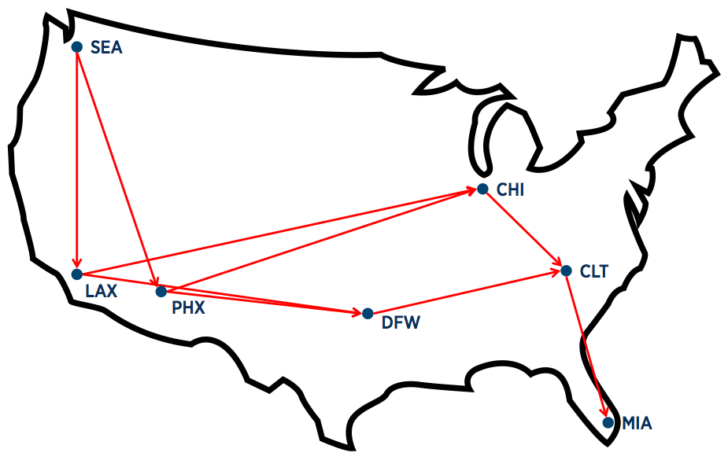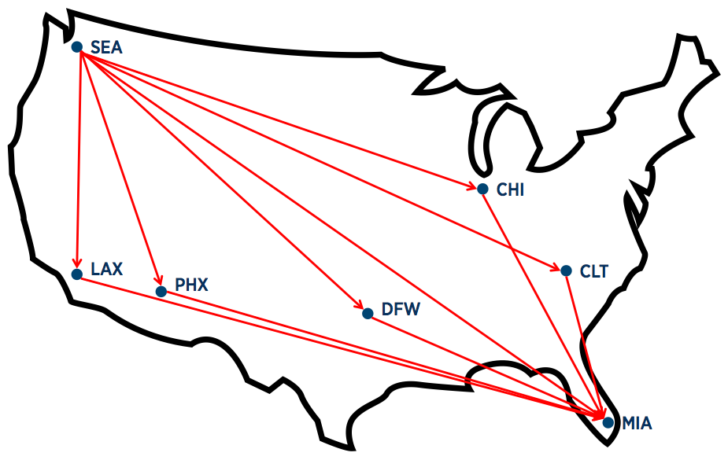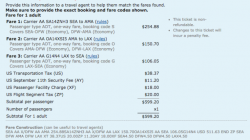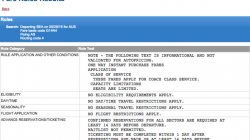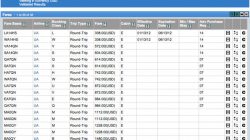This is the fifth and final post in my introductory series to using ExpertFlyer for more advanced travelers. I’ve mentioned fare routing rules in passing several times but not in the same depth they deserve. For the most part these guidelines will only be helpful for booking revenue fares. All loyalty programs have their own rules for award travel.
Other posts in this series:
- Introduction to ExpertFlyer: Fare Rules and Prices
- Introduction to ExpertFlyer: Finding Availability and Constructing Fares
- Introduction to ExpertFlyer: When Manual Fare Construction Helps or Hurts
- Introduction to ExpertFlyer: Combining Fares and Pricing Units
- Introduction to ExpertFlyer: Planning an Award Trip
As indicated in my own posts and some of the comments, not all of this information is immediately practical — you may be better off letting a search engine do the work for you. But understanding the process can lead to more educated search behavior, perform a gut check when prices appear too high, and uncover some hidden opportunities.
Finding Routing Rules
Routing rules can be found in ExpertFlyer by first performing a search for published fares. On the results page, click on the button that looks like a zigzag. This will open the specific routing rules for that fare. (The more detailed fare rules are a separate document, which you can open by clicking on the button that looks like a page of text.)
It’s my experience that most fares between two cities have similar fares, but this isn’t guaranteed. For example, more expensive fares may have more flexible rules. Also be aware that the fare rules trump the routing rules. For example, the fare rules might say that only two transfers (connections) are permitted, or that you aren’t allow to fly on codeshare partners. It doesn’t matter if the routing rules display options with three or more transfers or list cities that are only served by a partner.
Domestic Routing Rules
The vast majority of domestic fares publish routing rules as a list of cities or airports and the possible connections between them. They are often overlapping, and everything is optional. Decipher the routing rules by looking for slashes (“/”) and dashes (“-“). These routing rules also explain what’s allowed — not what’s possible. Flights between some airports may not exist.
- Dashes indicate connections between two different airports. However, you are not required to fly that segment! You can skip ahead to the next airport, or all the way to your destination.
- Slashes indicate a choice between more than one airport. So you can fly to airport A or to airport B before continuing onward. Sometimes the choices don’t make logical sense because the same airport is listed as an option on both sides of a dash.
Here’s an example of the routing rules from a sample fare between Seattle and Miami on American Airlines. You can choose any one of the four routings, and within each routing there are opportunities to choose different connecting airports or skip a connection altogether.
- SEA-PHX/LAX-DFW/CHI-MIA
- SEA-DFW/CHI-MIA
- SEA-PHX/LAX-DFW/CHI-CLT-MIA
- SEA-DFW/CHI-CLT-MIA
Of these, #3 is really the only one we need to pay attention to. The others are all versions of #3 with certain connections removed, e.g., #2 removes the options to connect at PHX/LAX and at CLT. But we’re not required to make these stops anyway, so #2 does not offer anything new. This is what I mean when I say some routings are overlapping.
What the routing rules suggest in theory is very rarely what people book in practice. Here is an example using routing #3 above.
Theoretical Routing
All of these options include three connections. You’ll start in Seattle, fly to either Los Angeles or Phoenix, then fly to either Dallas or Chicago, and then fly to Charlotte before ending in Miami. You have the option to skip some of these legs, such as by flying directly from Seattle to Dallas. These routing rules also make it clear what you cannot do. For example, it is not a legal routing to fly to Dallas first and then Los Angeles before ending in Miami, even though non-stop flights exist between these cities.
Practical Routing
Thanks to the hub-and-spoke model of most major airlines, the more practical way to read these routing rules is as a list of hub airports through which you may continue your journey to Miami. It’s very likely that you can fly to any one of the cities listed and, with just one stop, complete your trip. There’s even a Seattle-Miami non-stop flight. But I can’t connect in JFK or Philadelphia even though both are hubs of American Airlines.
If you find a particularly inexpensive fare and you face limited availability on the flights that connect these cities, that’s where the more complex routing rules can become useful. By jumping around the country and making additional stops you will have more flights to choose from. Hopefully some of those will have availability in less expensive booking classes.
Additional connections are also at the heart of mileage running. I could earn a lot of miles by flying from Seattle to JFK, back to Los Angeles, and then up to Chicago before ending in Miami. Sadly, it’s not allowed. The most lucrative route is probably SEA-LAX-CHI-CLT-MIA.
International Routing Rules
When trying to plot your itinerary for an international flight, the process can be much simpler. Some airlines publish routing rules in the same way they do for domestic flights. Here’s an example of a Singapore Airlines fare between Los Angeles and Sydney, with only one available routing:
- LAX-TYO-FUK/NGO/OSA-SIN-MI/SQ-SYD
Again, you don’t need to make all of those connections if you don’t want to. It’s perfectly alright to fly LAX-TYO-SIN-SYD without making an additional stop in Japan. But you can’t choose to stop in Hong Kong. Toward the end it lists “MI/SQ” meaning you have a choice between Silk Air and Singapore Airlines for that final segment between Singapore and Sydney
Here’s another example of a United Airlines fare between Seattle and Hong Kong:
- SEA-SJC/SFO/SEA/LAX-HNL-WP/UA/HA-OGG/MKK/LNY/LIH/KOA/JHM/ ITO-WP/UA/HA-HNL-GUM-HKG
- SEA-HNL-WP/UA/HA-OGG/MKK/LNY/LIH/KOA/JHM/ITO-WP/UA/HA-HNL- GUM-HKG
- SEA-SJC/SFO/SEA/LAX-HNL-WP/UA/HA-OGG/MKK/LNY/LIH/KOA/JHM/ ITO-WP/UA/HA-HNL-TYO/OSA-UA/NH-TYO/OSA-UA/NH-HKG
- SEA-HNL-WP/UA/HA-OGG/MKK/LNY/LIH/KOA/JHM/ITO-WP/UA/HA-HNL- TYO/OSA-UA/NH-TYO/OSA-UA/NH-HKG
- SEA-SJC/SFO/SEA/LAX-HNL-WP/UA/HA-OGG/MKK/LNY/LIH/KOA/JHM/ ITO-WP/UA/HA-HNL-TYO/OSA-UA/NH-TYO/OSA-UA/NH-SEL-OZ-HKG
- SEA-HNL-WP/UA/HA-OGG/MKK/LNY/LIH/KOA/JHM/ITO-WP/UA/HA-HNL- TYO/OSA-UA/NH-TYO/OSA-UA/NH-SEL-OZ-HKG
It’s much more complicated, and it’s unlikely you would make as many connections as it offers. For example, SEA-HNL-JHM-HNL-TYO-OSA-SEL-HKG includes backtracking to the very small Kapalua Airport in west Maui via Honolulu. Most fare rules do not permit you to visit the same airport twice.
Maximum Permitted Mileage
More often I see routing rules for international flights that use a measure called “maximum permitted mileage” or “MPM.” Here’s my final example, using an American Airlines fare between Dallas and London. (I’ve made some additional formatting so you can see the relevant airports listed.)
/VIA THE ATLANTIC/ MPM 5702 MILEAGE SYSTEM APPLIES BETWEEN ORIGIN AND DESTINATION MILEAGE SYSTEM APPLIES ORIGIN TO DESTINATION
TICKETED POINT DEDUCTION OF 500 MILES APPLIES WHEN TRAVEL IS VIA WAW OR VIE OR ZAG OR STO OR OSL OR CPH OR GSE OR SVG OR IST OR GERMANY OR SWITZERLAND OR BELGIUM
TICKETED POINT DEDUCTION OF 550 MILES APPLIES WHEN TRAVEL IS VIA CHI AND/OR NYC AND/OR RDU AND/OR MIA AND/OR DFW
TICKETED POINT DEDUCTION OF 550 MILES APPLIES WHEN TRAVEL IS VIA CHI AND/OR DFW AND/OR RDU AND/OR MIA
MPMs are created by the International Air Transport Association and can be looked up separately if you visit the “Travel Information” page on the ExpertFlyer navigation menu. But it’s helpful that the number is provided here, too. It’s the total distance you’re allowed to fly between your origin (Dallas) and destination (London Heathrow) on this fare. As indicated, travel must be via the Atlantic Ocean even if you manage to find a shorter distance via the Pacific Ocean. And there are no rules on where you’re allowed to connect or how many connections are permitted. Those restrictions — if any — can be found in the fare rules.
As when filing a tax return, “deduction” implies a credit in your favor, so a ticketed point deduction of 500 miles means the MPM is raised by that amount when you meet the listed conditions. Here’s an example of two options to get from Dallas to London:
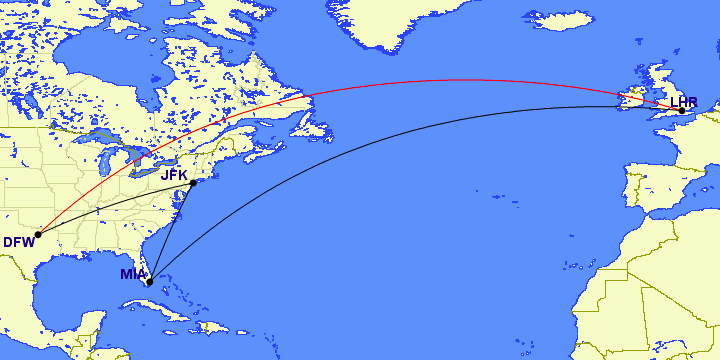
You could easily book the non-stop flight between these two cities, which is 4,750 miles, and stay under the MPM of 5,702 miles. Even adding a connection in Chicago or a few other airports will stay under the original MPM, with no deduction necessary.
If you push the limit by connecting in both New York and Miami, then the total distance increases to 6,905 miles. Adding the deduction of 550 miles to the MPM establishes a new threshold of 6,252 miles, which is still not enough. So it is not a legal routing to connect in both cities.
Just because this combination of airports proved to be too much doesn’t mean we can’t make two connections. The routing rules only care about distance. If you were to connect in Raleigh-Durham and Miami, that itinerary would be only 6,186 miles, just under the adjusted MPM.
Conclusion
Reading and interpreting fare rules is really not that complicated. Like many things in travel there is just so much to read, much of it contradictory, duplicative, or otherwise irrelevant to your needs. You should have come away from this post with three lessons:
When reading fare rules that list connection options, learn to filter those results quickly. All you really need to know is which airports are permitted. If you’re making just one stop the order doesn’t matter.
When reading fare rules that list MPM, you’ll almost always be safe if you stick to reasonable routings. Use GCMap.com to explore options that make sense to you, and check against the MPM provided.
The only times you need to get messy are when (A) you want to get some extra miles for the same price or (B) you can’t find availability in the correct booking class on more direct flights. Adding deductions to the MPM or exploring unconventional connections will be helpful, but you may need to call an agent or use a multi-city search to book these itineraries. Note that taxes and fees will almost always increase as you add more segments, but the base fare should remain constant.



